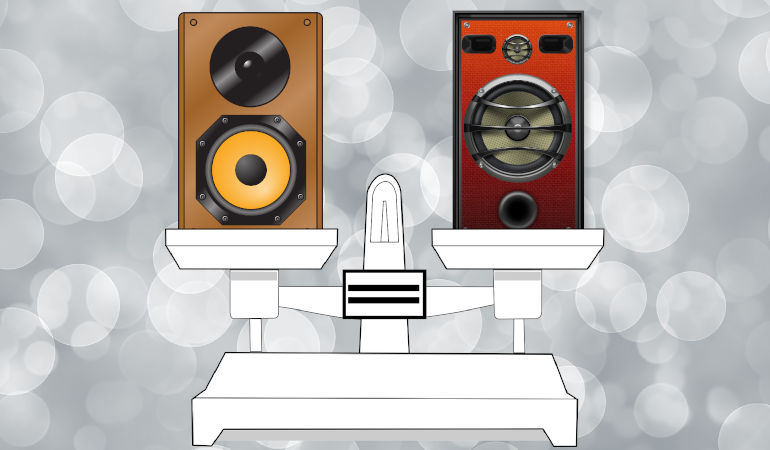How To Compare Home Theater Speakers
You’ve decided to shop for home theater speakers. You run to the Internet and there are no end to the suggestions. The fun part? Depending on the website, you’ll find that some brands are favored. Go to a different website and you’ll find the same speakers being derided while others are offered up as a pinnacle of sonic bliss. But there is one common refrain – you have to hear a speaker for yourself before you buy. But how? How do you compare home theater speakers?
In-Home Auditions
The only way to know how a speaker will sound in your room is to hear it in your room. No showroom or store is going to sound like your room. In fact, our out speaker buying guide starts with the room for a reason. Your room will seriously affect how any speaker will sound. In-home auditions are a must.
There are two main ways to do this – order online or shop locally. In both cases, you want to check the return policies. Online retailers like SVS and Aperion Audio offer free in-home auditions. You pay for the speakers upfront, but you get all your money back if you don’t like them. They don’t even charge you for return shipping. Other online retailers will allow returns but you are on the hook for the return shipping.
Some local shops have free returns. Others will charge you a “restocking” fee. We recommend double-checking anything you are told by a sales associate. They don’t always know, and the less scrupulous ones will out-in-out lie to you. Regardless, if you are bringing in online or local speakers, make sure you know the return window. Some are longer than others.
Bring In Similar Speakers
When comparing home theater speakers, you want to compare apples to apples. If you are ordering online, and you’ll be on the hook for return shipping, size and weight matter. For this reason, we usually recommend bringing in bookshelf speakers. Even if you are planning on buying towers, the bookshelf speakers in the same line should sound very similar. Plus, unpacking and packing tower speakers is a nightmare. Bookshelf speakers are much easier. While you can’t always get speakers with the exact same performance parameters, comparing bookshelf speakers to each other should be good enough.
The downside of bookshelf speakers is that you’ll need stands. Since this is your home and your audition, don’t kill yourself trying to get professional stands. If you are handy, throw something together with some scrap wood. Or rig something up in your room (using the shipping boxes is common). It doesn’t matter. What does matter is that they are in your room and at the correct height.

Placement
When setting up the speakers for a listening test, place them as close as possible to where your front left and right speakers will eventually live. Of course, that is impossible with two sets of speakers. To combat that, the general school of thought is that you alternate. If speaker A is on the outside of speaker B on the left, they should be switched on the right. Honestly, I really don’t think this matters all that much when you are comparing home theater speakers you plan on buying. But, that’s the recommendation.
Of course, you’ll want to adjust the toe-in for each pair individually. You’ll also want to get an idea of the sensitivity and efficiency of each speaker. If one set is much more efficient, they’ll be louder with less power. Louder can trick your brain into thinking something is better. Using an SPL meter or app will give you an idea of how much you should adjust the volume when you switch between speakers. You’ll want your AV receiver in Pure mode to disable any room correction.
The only caveat here is if you have a very recent AV receiver, you may have more than one memory slot. You could run the room correction for each set of speakers and switch out the presets as you compare. That would be optimal as it will tell you exactly how the speakers will perform with your gear. But most of us can’t do that.

How To Switch Between Speakers
There are all sorts of speaker selector switches out there. Some of them will even help you adjust the volume between the two speakers. Since you are probably going to do this all of once or twice in your life, that seems like a waste of money to us. If you don’t have speaker terminals for Speakers A and B, then you’ll have to swap the speaker wires.
Now, someone out there is already angrily typing in the comments. They are saying, “Your memory for audio is only three seconds! No way you can switch the wires that quickly!”
First, we’ve looked for the study that everyone seems to think exists that has that stat about audio memory. We can’t find it. While you’re commenting, go ahead and link us up. Thanks.
Second, who cares? We aren’t looking for small differences here. We are looking for the speakers that sound best in your room. If they are so close in sound that you need a less than three-second switching time, then other aspects of the speaker will make the decision. Those speakers basically sound the same. Get the prettier ones. Or the cheaper ones. Or the ones that your partner likes the best.
Play Some Sweeps
Head over to Audiocheck.net and download a sweep. You’ll want something that does the entire frequency range at the very least. Run the sweep through each set of speakers a couple of times. You want to get a sense of the bass response and evenness of each of the speakers. Keep in mind during your listening tests with actual content the differences in bass response. When you actually set up whichever speakers you end up with, they’ll be paired with a subwoofer. Bass response will be irrelevant.
To combat this, you can set your speakers to small in your setup menu and then turn off your subwoofer. Your receiver will still apply the crossover to the speakers but the subwoofer will not play. This allows you to compare each speaker as they will actually be used.
Get To Comparing
These are your speakers in your house. There is no right way to compare home theater speakers that are really only meant to please you. Listen to some music that you are extremely familiar with and switch between two sets of speakers. If one stands out to you as “better,” keep it in place and swap in a different set. Keep doing that until you are sure you like one pair best. Then buy it.


